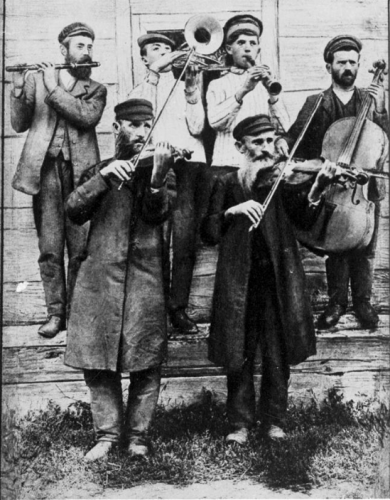Nash Holos: The Roots of Klezmer

Klezmer music … it’s instantly recognizable, yet almost impossible to define.
It’s a unique sound with a heritage deeply rooted in the shtetls, the Jewish villages of Eastern Europe.
The term klezmer is derived from the Hebrew roots “kli-zemer” or “vessel of song.” It reflects the ancient Jewish belief that a musician is not really a creator of music, but rather a vessel through which music flows.
It also refers to professional Jewish folk musicians of Eastern European origin. Since the 1970s (nineteen seventies), it also has been used to describe the genres of music they performed.
However, you want to define it, klezmer is a cultural phenomenon which played an integral part in the culture and celebrations of Ukrainian and other Eastern European Jewry.
The tradition of klezmer in Europe dates back to the 16th (sixteenth) century. From then and until the 1930s, klezmorim, or klezmer performers, played an important role in Jewish communities.
Klezmorim were hired to play at Jewish weddings and other gatherings … as well as at non-Jewish functions. And sometimes, non-Jewish musicians played at Jewish events. As a result, klezmer music became a rather eclectic mix of Eastern European folk styles. So it is historically accurate to say that klezmer was the original “fusion” music!
The first instruments used were “traditional” — the violin, cello, hammered dulcimer (tymbaly in Ukrainian), flute and piccolo. More recently, the accordion was added, along with the clarinet, saxophone, guitar, and the other instruments commonly used by klezmorim today.
The original intention of klezmer was for musical instruments to imitate the voice of the cantor in the synagogue. The first Klezmer tunes were in fact based on the chanted Hebrew melodies of the Jewish service. Because it structurally corresponds to traditional marital rites, Klezmer soon became popular for weddings. Then gradually it became common at bar mitzvahs, birthdays, a new synagogue’s inauguration or the arrival of a new Torah roll, visits by celebrities, and other happy events.
From 1881 to 1924 a wave of Jewish immigrants from Eastern Europe arrived in the New World. Naturally, they brought their music along and performed for all kinds of celebrations, as in the Old World. However, their North American-born sons and daughters considered klezmer music an embarrassment. This generation was eager to assimilate into the American “melting pot.” For them klezmer symbolized the “ghetto mentality” of the shtetl, and they wanted no part of it.
At the same time, back in Europe … the Holodomor, the Holocaust and the Iron Curtain cut off North American klezmer from its roots.
And, for a while, klezmer all but disappeared from the face of the earth.
But in the 1970s, klezmer experienced a surprising revival. In the west, descendants of the immigrants and survivors of European genocides became interested in their roots. They “discovered” vintage recordings of renowned klezmorim such as Naftule Brandwein and Dave Tarras … and they quickly began to make up for lost time.
By the 1980s, the klezmer revival had spread from North America to Europe … and even to Israel, where suddenly Yiddish became chic again.
And in the post-communist world of its birthplace, among other things, klezmer is fuelling the revival of Yiddish.
Throughout Ukraine today, and in neighbouring countries, klezmer can once again be heard … on the streets, … at festivals, … in workshops and schools … and at private functions.
No longer an embarrassment, klezmer has evolved into an art form with a heritage that … has a universal appeal. While strictly Jewish … klezmer is nonetheless enjoyed, and shared, by people and cultures around the world.
This musical evolution may, perhaps, make klezmer harder than ever to define. However, there is no mistaking it when you hear it!
For more information on the work of the Jewish Heritage Museum, please visit their website.
Listen to the program here.
Ukrainian Jewish Heritage is brought to you by the Ukrainian Jewish Encounter (UJE), a privately funded multinational organization whose goal is to promote mutual understanding between Ukrainians and Jews. Transcripts and audio files of this and earlier broadcasts of Ukrainian Jewish Heritage are available at the UJE website and the Nash Holos website.



















